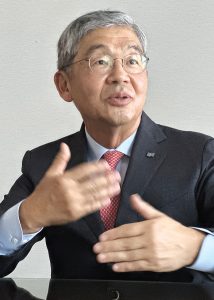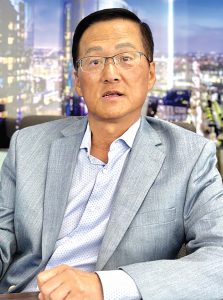[The Korea Daily’s 50th-anniversary special: Part 2]
Korean-American banks, the fashion and fabric industry, and real estate development are often called the main driving forces of the rapid growth of the Korean-American economy in Los Angeles. In the early days of immigration especially, Korean-American banks were not just any banks. They played a cornerstone role in helping Korean immigrants with no credit to open their businesses and thrived alongside Korean Americans. The real estate development that began around Koreatown is credited with spurring the Korean-American economy to reach new heights. The interviews with Kevin Kim, CEO of Bank of Hope, the first Korean-American regional bank, and Paul Kim, President of Jamison Services, the company that spearheaded the real estate development of Koreatown, look at the past, present, and future of the Korean-American economy. -Ed.
2nd-generation influx leads to industry diversification

[Interview with Kevin Kim, CEO of Bank of Hope]
Bank of Hope, the largest Korean-American bank, was established in 2016 through the merger of BBCN and Wilshire Bank, which was founded in 1980, and became the first regional bank among Korean-American banks. Bank of Hope has grown alongside the Korean-American business sector as well as the Korean-American community.
Looking back over the past 50 years, CEO Kevin Kim recognized that the Korean-American economy has made remarkable progress, and the Korean-American financial sector has played a pivotal role in its growth.
Kim says the Korean-American economy in the U.S. is unique in that it has grown through a close relationship between the U.S. and the Korean economies. As the Korean economy has evolved from a light industry to a heavy chemical industry, the Korean-American economy has also grown along with it while Korea has become an economic powerhouse. Korean immigrants initially worked laborious jobs, saved up capital, and established themselves as small businesses. Later, Korean-American businesses grew into medium- to large-sized companies in many industries, paralleling the hyper-growth of companies in their home countries.
“Initially, Korean-American banks focused on business loans, such as operating funds for Korean immigrants, and then gradually expanded to SBA and commercial real estate loans,” Kim said. “To meet the diverse financial needs of Korean-American businesses as they evolved, the banks grew in size and capacity.”
A transitional period has come where the second generation is taking over the businesses that the first generation built with their blood and sweat and upgrading them to the next level. “We’re seeing a significant increase in the number of second-generation Korean Americans following in their parents’ footsteps in various economic sectors across the country,” Kim said.
Kim emphasized the importance of identity and openness when looking at the future of the Korean-American economy, pointing out that Korean-American businesses must be open to expansion to mainstream but at the same time be able to preserve their identity.
“Recent changes in Koreatown show this trend,” he said. Customers of other ethnicities are now enjoying Korean food at Koreatown restaurants that were once only frequented by Korean Americans. Businesses that were stuck in Koreatown are now thriving by attracting non-Korean customers.
Kim attributes this shift to the second generation of immigrants entering the Korean-American business sector. Here, he sees a promising future for the Korean-American economy as it diversifies away from a concentration of businesses in certain industries, and as more high-performing companies emerge in the mainstream economy.
“Bank of Hope has also made a lot of efforts in recent years to become more competitive with mainstream banks, such as actively recruiting non-Korean employees,” Kim said, ”but we have not diluted our identity as a Korean-American bank and we still maintain strong ties with the Korean-American businesses.”
Kim added that the Korean and the U.S. economies are currently in a downturn and that each member of society must play a role in overcoming it. He emphasized that the Korean-American community has the strength to overcome recurring recessions, just as it has overcome the Asian financial crisis, the 2008 financial crisis, and the pandemic in 2020. With this history, combined with the pioneering spirit and creativity of Korean Americans, Kim believes the Korean-American economy will continue to be robust in the next 50 years.
BY WONHEE CHO, HOONSIK WOO woo.hoonsik@koreadaily.com
Koreatown should have its distinct color

[Interview with Paul Kim, President of Jamison Services]
In the business of commercial and residential development and new construction since the early 1990s, the Jamison Group has had a substantial impact on the overall growth of Koreatown in Los Angeles.
With its recent focus on multifamily unit development from Downtown to West LA, Jamison Group is comprised of three companies, Jamison Properties for development, Jamison Realty for sales, and Jamison Services for management and operations.
Paul Kim, President of Jamison Services, which manages a $3 billion portfolio in Southern California consisting of approximately 18 million square feet of commercial, medical office, retail, and mixed-use properties, spoke about the current state and outlook of Koreatown.
“Normally, you look out half a century or a decade,” said Kim at Jamison Group’s office on Wilshire Boulevard in Koreatown, ”but it’s changing so rapidly that it’s almost impossible to predict even five years ahead.”
“First and foremost, the demographics of Koreatown are shifting fast, which is currently greatly affecting the Korean-American business and real estate markets. This will be the key factor in the future of Koreatown’s growth.”
According to Kim, the percentage of Korean-American renters has dropped from 50 to 60% 15 years ago to 30% today, with 30% Chinese and 40% other ethnicities. Commercial buildings have also seen the number of Korean-American tenants drop to as low as 25%.
Explaining the declining Korean-American population, Kim said, “The number of new Korean immigrants has plummeted, and the existing Korean-American families with young children are leaving Koreatown. Another reason is that the number of Korean business startups in the neighborhood has also decreased significantly, except for legal and medical-related businesses.”
Kim pointed out that in order for Koreatown to further grow, it must revitalize the businesses. “To revitalize the businesses in Koreatown, the area should attract a notable amount of increased foot traffic of second- and third-generation Korean Americans as well as customers of other ethnic groups. Now, they must target broader customers than just focusing only on ethnic Koreans in order to survive,” Kim said.
“Above all, we need a distinct color for Koreatown. For example, at Chapman Plaza, many second-, third-generation, and other ethnic groups are gathering as Korean food, Korean beauty, and other cultural products are gaining popularity from the recent Hallyu (Korean wave) boom. Transforming such parts of Koreatown into a specialized cultural district would be one way to do this.”
Jamison Group’s recent development focus has been on 6th and 8th Streets between Western and Vermont Avenues.
“We expected the commercial real estate market to recover after the pandemic, but as office demand has plummeted due to remote work from home, we are accelerating the conversion of residential units. The 6th and 8th Street areas are one of the locations with the greatest potential for increased foot traffic as they attract residents and businesses through the development and conversion of residential buildings.”
Turning to future business trends, Kim said, “Since 2013, we have delivered 6,336 residential units, with another 2,000 units under construction. With commercial rental demand down, it’s logical to convert existing buildings into hotels and apartments. We plan to redevelop or construct new condominiums to address the rising cost of housing, which is becoming increasingly unaffordable. Retirees and seniors will also find condominiums more favorable than apartments, as they can fix their monthly expenses.”
BY NAKI PARK, HOONSIK WOO woo.hoonsik@koreadaily.com




